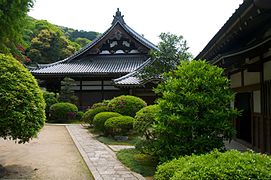Chion-in
The Chion-in ( Japanese 知恩 院 ) with the mountain name Kachōzan ( 華 頂 山 ) is a temple in the Higashiyama district of Kyoto City , Japan (north of Maruyama Park and the Yasaka Shrine ). It is the main temple of the Jōdo direction of Buddhism .
history
The burial site, which was initially built after Hōnens' death in 1212, was burned out of fear of the Hiei-zan's bigwigs in Aono on the eastern edge of Kyoto and the ashes were distributed among the disciples. In 1234, Seikambō Genchi ( 勢 観 房 源 智 ; 1183-1239) restored the burial place and built the Buddha Hall, the Mie-do ( 御 影 堂 ) and other buildings. This temple complex was called Ōtani-ji ( 大谷 寺 ). The temple was destroyed in the Ōnin war , but then rebuilt.
In 1523 a dispute began with the Chion-ji about who was the main temple of the Jōdo direction. In 1575, Emperor Ōgimachi decided this dispute in favor of Chion-in. The rulers of the time, Oda Nobunaga , Toyotomi Hideyoshi and especially Tokugawa Ieyasu supported the temple. This increased the temple income to 700 koku , which was then further increased by the imperial family to 1040 koku. In 1633 the temple burned down largely in a large fire, but could be rebuilt, now supported by the third Shogun Tokugawa Iemitsu . The current appearance dates from this time.
The attachment
(In the following, national treasures are marked with ⦿, important cultural assets of Japan with ◎.)
You enter the temple through the large, free-standing temple gate ( 三門 Sammon ; ⦿), which was designed as a Nijūmon . It has long been assumed that it dates from 1619, but a structural inspection a few years ago found inscriptions indicating that completion took until 1621. With a width of 26.70 meters and a depth of 12.30 meters, it is the largest temple gate in Japan. - On the upper floor there is a Shaka-Buddha and 16 rakan .
The large main hall ( 本 堂 Hondō , also Mie-dō ( 御 影 堂 ); ⦿) measures 44.82 m at the front and has a depth of 32.25 m and is covered with a hip roof. In it the image of Honen is venerated on the central altar pedestal. - To the north of it, the inner temple area connects with the “assembly hall” ( 集会 堂 Shūe-dō ; ◎). It has an area of 450 tatami (742 m²). The large and small abortion residences ( 大 方丈 Ōhōjō and 小 方丈 Kohōjō ; both ◎) connect to the north. They were built in 1641 in the shoin style . The rooms are painted by the artists of the Kanō school Tsunenobu, Nobumasa and Koi, in the large residence on a gold background, in the small residence as ink painting. The corridors are designed as “chirping corridors” ( 鶯 張 り uguisubari ): the floorboards creak when entering. In front of the residences, there are gardens around two ponds. The large and small “refectory” ( 大 庫裏 Ōguri and 小 庫裏 Koguri , both ◎) also belong to the inner temple area. Access to the residences is through a Chinese-style gate, a karamon ( 唐門 ; ◎).
The exceptionally large "Sutrenspeicher" ( 経 蔵 Kyōzō ; ◎) from 1621 has a pyramid roof. The memory contains a complete collection of sutras ( 一切 経 Issai kyō ; ◎) from the Song Dynasty . To the south of it is the "ossuary" ( 納 骨 ō Nōkotsu-dō ), built in 1930 , next to it the large bell tower ( 大 鐘楼 Daishōrō ) with the temple bell ( 梵 鐘 Bonshō ). The 80-ton bell is the largest in Japan. When the bell rings for the Japanese New Year , 17 monks are therefore necessary to set it in motion. - The hall for Zen meditation from the year 1530, called Seishi-dō ( 勢 至 堂 ; ◎), is located in the back of the temple .
Temple treasures
The temple treasures include the following documents: the Sutra Bosatsu Shotai kyō ( 菩薩 処 胎 経 , Western Wei ; ⦿), the Sutra Dairotan kyō ( 大楼 炭 経 ; Tang Dynasty ; ⦿), the explanation Jōgū Shōtoku hōōtei setsu ( 上 宮 聖 聖法王 帝 説 ; Heian period ; ⦿). The temple also has the tradition of Hōnen's life adorned with colored pictures ( 紙 本 著色 法 然 上人 絵 伝 Shihon choiro Hōnen jōnin e-den ; ◎) and other picture roles .
photos
Used literature
- Kyoto-fu rekishi isan kenkyukai (ed.): Chion-in . In: Kyoto-fu no rekishi sampo (chu). Yamakawa Shuppan, 2011. ISBN 978-4-634-24726-0 . Pp. 122 to 125.
Web links
- Temple website (Japanese)
- Temple Chion-in at Culture-in-Asia: Part 1 with description - Part 2 - Part 3 - Part 4 - Part 5
Coordinates: 35 ° 0 ′ 23 ″ N , 135 ° 47 ′ 2 ″ E









